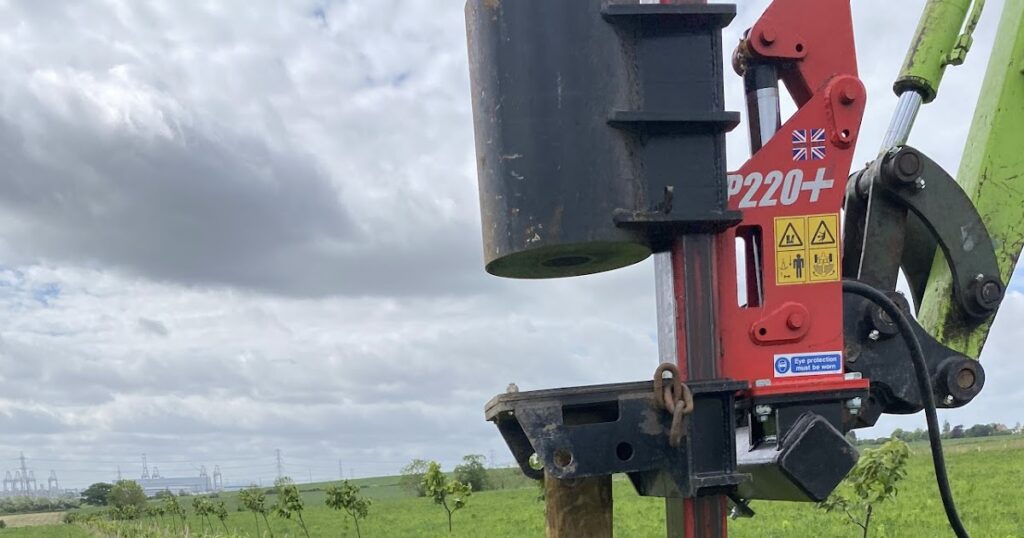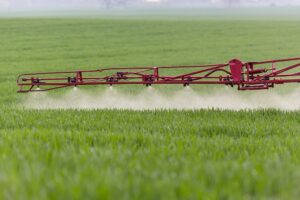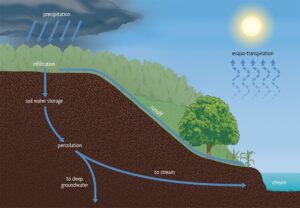One of the important things was to tackle the agroforestry field, Spratts. When we initially planted the field with over 6,500 trees, I was advised to use some compostable weed suppressant mats. These were made from hessian and jute and would apparently last for approximately four years, keeping the base of the trees weed free, allowing them to grow freely. The mats weren’t too expensive at around 96p each, including bamboo hold-down pegs. But they were reasonably labour intensive to install.
Having put these at the base of my trees, it soon became apparent that the product was rubbish… Grasses began growing through the mats, and soon enough the trees were receiving little-to-no protection from competitive weeds. This needed addressing.
After a lot of research, I settled on using wood chip, and many phone calls later found a place near Billericay where we could cart mulch from. Many loads later, and with Paul having done a lot of manual shovelling, we now have approximately a square metre of mulch, ten centimetres deep, around each of the trees. A lot of work, and a frustrating additional expense. But the mulch works on a number of fronts: besides keeping weed competition at bay, it also captures moisture when it rains, hopefully giving the trees a better chance of survival. This is something I definitely wish I had known at the time of tree-establishment in 2020. However, hopefully by spreading my mistake in this blog, others won’t also make it!
The other agroforestry work that we commenced this month is fencing each of the tree belts. The cows are due to be grazing in amongst the trees again soon, and said trees are still at least a decade away from being large enough to take grazing animals amongst them. Temporary electric fence has been my go-to for the past eighteen months, but it is so time consuming to erect that this semi-permanent fence should make grazing Spratts a much more enjoyable affair.
 |
| The start of fence erection in the agroforestry. Very glad that I purchased a proper digger-mounted post banger last year. |
This year very much feels like the year of infrastructure on the farm in Fobbing. With that in mind, we have been busy preparing for 2022’s large fencing project, which will ensure that my livestock are protected from any rogue dog walkers and their potentially diseased faeces. In order for the fencing to work, we have been piping some sections of ditch to enable the fence to go over the top of it. Putting culverts in like this also enables my livestock to graze down the ditch banks, which in turn opens up some really exciting ecological habitats.
 |
| The first of three fencing deliveries… |
Last month’s article spoke a lot about the issues I had with calving, some of which I attribute to neosporosis (the dog-poo borne disease). Having struggled with this year’s calving, I am now taking a zero-tolerance approach when it comes to disease in my cows, which has led to some tough decisions.
In the middle of April I got Mia to come and test my cows, as well as see which animals were in-calf to Kestrel who served them over the Christmas period. Ten out of thirteen cows were scanned as pregnant. Two were definitively not in-calf. And one Mia described as a pseudo-pregnancy, i.e., her body thought she was pregnant, but there was no actual foetus present. To be doubly sure we will scan her again, but it looks likely that she is empty (quite a shame, because this cow was one of my favourites from this group). Considering I only ran the bull for five weeks this time, and a cow cycles every 21 days, I am pretty pleased by the number that are in calf. I am also annoyed at myself that I didn’t leave the bull for another week so that all cows got two full cycles with the bull, but apparently I wasn’t thinking clearly at the time.
 |
| I’m pleased by how good I am getting at setting up cow pens and races now, and getting the animals in! |
 |
| Mia getting ready to scan the first cow. She had always complained in the past about climbing over gates to enter the race (cattle chute), so this time I installed this handy access gate. The only issue was that the cross bar happened to be at head height! Mia banged her bonce once, but I felt especially bad for the student who was with Mia. She was obviously concentrating on learning how to take blood from the tail, and consequently managed to hit her head eight or nine times, ending up with quite the egg. She got a hot crossed bun at the end of the job though, so it wasn’t all bad! |
The blood results came back, and on the whole were as expected (matching previous tests that I had done on the cows). That said, there was one shock to the system…
My sixth calf born on the farm was Albert. Born to Cow-81 who unfortunately had the breech calf ceasar’d dead last month. Cow-81 is up there as a favourite cow. And Albert is simply gorgeous. Incredibly friendly and docile. Given his beautiful temperament, I had decided that I could keep Albert as a tame steer (a castrated male). There are a number of uses for this, including calming down groups of bulls or cows. Being castrated, he couldn’t cause me any issues either!
 |
| Picture of Alb taken last Summer. |
So it was really gutting to hear that Albert managed to contract
leptospirosis on the farm. Lepto is a disease that is contracted from water-courses, and given that my cattle have free access to these water courses (for ecological reasons) it is not especially surprising. I had just hoped from previous blood results that the waterways here were clean. Apparently not.
 |
| I have affectionate animals this year too. But there won’t ever be another Albert. At certain times, livestock farming gets really tough. I’ll be in bits if there is another BSE or Foot & Mouth crisis that requires extensive culling. |
In theory it is possible to treat lepto with antibiotics, but it isn’t a guaranteed treatment, and would involve stressing Albert by penning him daily to administer antibiotics. So I think it is fairer to just let him go. Even if that decision has been galling for me (and my oldest nephew, Jack).
 |
| Albert in a hat, also from last Summer. He is much bigger now. |
One good thing is that it is possible to vaccinate for lepto which will protect against future infections. Vaccination was something I was actively attempting to avoid. However, when it comes to a disease like lepto, I can’t protect against it just by keeping the herd closed (i.e., not buying in stock from other farms). One way to keep it out of my animals would be to fence all my ditches etc. But the value of the animals’ natural destruction of small areas of ditch line is so critical for biodiversity, that in this instance vaccination is definitely the right call for me.
 |
| For me, these three pictures really show the importance of livestock carefully having access to water courses. This picture is taken immediately next to the below. The cows had full access to destroy these reeds, but chose not to… |
 |
| Before the cows entered the paddock, this stretch of ditch-line looked identical to above. However, they have cleared here, opening up the bank for new species of plants to grow, and new invertebrates and other animals to come in. |
 |
| Another example with a pond here that they love to graze. Critically, because the cows move regularly, they never extensively damage habitats, and perform a really good level of disturbance. If I have to vaccinate for lepto for these eco-benefits, then so be it. |
With information on my ‘clean’ and ‘diseased’ animals back from the lab, I was then able to get the animals penned once again, and separate them. The clean, breeding herd is now on one half of the grazing land, and the cull herd with disease is grazing the other half. My aim is to be 100% clean in approximately two years’ time, but I am sure I will be greeted by some unexpected curve balls on the journey!
To be clear, much as though some of my herd have disease (BVD, IBR, lepto, Johne’s and neospora) there is no danger whatsoever from eating meat from these animals. There is no transfer of disease through to humans. So much as though I refer to one bunch as the ‘cull herd’, that simply refers to me fattening those animals to be killed for human consumption, rather than continuing to breed from them.
The 28th April saw the Soil Associate Conference occur in London, and I was very pleased to have been invited to speak on a panel (with Martin Lines, chair of the Nature Friendly
Farming Network, and Helen Browning OBE, chief exec of the Soil Association, as co-panelists). The joy of in-person
farming events being
a thing again cannot be overstated, and I revelled in being able to dress up for the occasion (sporting a vibrant pink jumper under a blazer!).
 |
| The word you are searching for is ‘dashing’. |
The day featured some excellent talks and discussions, notably Professor Tim Benton from Chatham House, and George Eustice MP. My feeling as ever when it comes to the politics of it all is that the Government might be saying all the right things, but the funding is not being made available to the right people to make the necessary changes happen.
 |
| A proper venue. With proper people! |
 |
| Professor Tim Benton delivering the keynote, which I strongly recommend checking out on the Soil Association YouTube channel. |
The panel I was involved in was talking about the financial ramifications of agroecological
farming (the type of
farming I bang on about all the time!). The Soil Association had commissioned a report into agroecology from an economic perspective, showing how well it holds up against conventional agriculture, whilst also demonstrating funding gaps. I contributed to the report and was very pleased to then get to comment on the findings at this event. My big point was to say that for me, agroecology is about removing risk from the
farming system. Many farmers are currently working with exceptionally high input costs (fertiliser as the main one, seriously affected by the war in Ukraine). Grain prices are strong for now, but it wouldn’t take much for that market to crash. And when farmers are often spending money on inputs 18-24 months before selling a crop, at current prices it feels like a risk too far, with agroecological techniques providing a potential new way of managing the landscape.
Since this article will be published in May, now is the time to promote Open Farm Sunday. This year, Open Farm Sunday is on Sunday, 12th June. Once again I will be opening the farm up for a big walk, with the opportunity to take a look at the heritage cereals I grow, my seed cleaning and flour milling set up, my beautiful species-rich herbal leys, the ecological projects I am currently working on, progress in my agroforestry trial field, as well as the star attraction of course: my lovely cows and calves! It would be super to see you here on the farm in Fobbing, but if you are too far to come to me, then please do take a look on the Open Farm Sunday website (
www.farmsunday.org) to see who is hosting an event nearer to where you are. My farm walk will be starting at 2pm, so please arrive in my farm-yard (Curtis Farm, SS17 9JJ) at 1:45pm for a timely set off (and make sure you have appropriate footwear and apparel for an offroad walk!).
Recently I made the decision to switch up how I distribute this blog. I have long since thought that having it purely in written form was stifling my reach, and consequently I came to the decision that I would record each episode as a monthly podcast (the written version will still be available in the village magazine, and the photo-illustrated version on
farmingGeorge.blogspot.com). The podcast will simply act as a companion to the blog. So if you wish to listen to my (hopefully) dulcet tones, please head to any of the major podcasting platforms (Apple / Spotify / Audible / Google) and just search for ‘farmingGeorge’ to find me. The first episode available is last month’s one about my calving issues, although my intention will be to record the entire back catalogue over the coming months. I’m quite keen to re-read my previous articles from the beginning back in 2018, and remember the changes that have been implemented on the farm!
The year really feels like it is beginning to kick into gear now, with May promising to be very busy: a number of interesting visits plus UK Grain Lab 2022. It’s exciting, but I wish I had a few more months before harvest comes along!
















